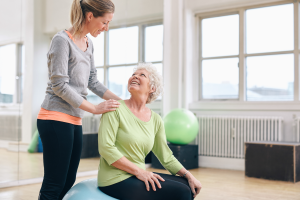
From helping our bodies move to protecting our internal organs, our bones play an important role in our overall health. Building and maintaining good bone health is crucial, as women are at greater risk than men of developing the bone disease known as osteoporosis. Osteoporosis is a serious disease that causes the bones to thin and become more fragile.
While a certain level of bone loss is natural as we age, osteoporosis is not. Osteoporosis affects 8 million women in the U.S. and can result in painful bone fractures.
Fortunately, there are preventive techniques that can help reduce the risk of developing osteoporosis later in life. If you have developed osteoporosis, there are treatments available to help rebuild bones to prevent further damage.
Understanding Osteoporosis
Osteoporosis literally means “porous bone,” and is often considered a silent disease as its effects are not noticeable until a fracture occurs. Often, its effects are not seen until after menopause when there is a drop in a woman’s estrogen level. Estrogen is an important hormone that contributes to a woman’s bone density. When estrogen levels decrease after menopause, the risk for experiencing bone loss increases.
When we picture someone with osteoporosis, we often conjure images of a woman with a stooped or hunched over posture. This is because osteoporosis can weaken the bones of the spine. Additionally, osteoporosis may lead to fractures of the bones in the hip or the wrist.
When the bones become weaker, they are more prone to breaking whether from a fall or even with actions as simple as sneezing, in the most severe cases. In some cases, a hip fracture can be life-threatening as it limits a woman’s ability to move and can present the risk of developing other complications like blood clots.
Risk Factors That Can Affect Your Bone Health
Outside of menopause, there are a host of conditions that can lead to bone loss and may increase a woman’s likelihood of developing osteoporosis. These conditions include breast cancer, eating disorders, diabetes, celiac disease, irregular periods, and more. Lifestyle choices like smoking cigarettes and excessive alcohol consumption (more than two drinks a day) have also been linked to an increased risk for osteoporosis.
In certain cases, osteoporosis has also been shown to be hereditary. If your mother or a close relative has experienced a fracture, you may be at greater risk, so it is important to discuss your family’s health history with your provider.
Treating Osteoporosis and Bone Loss
While prevention is the best technique for avoiding bone loss and osteoporosis, there are many treatment options available as well. These range from oral medications taken weekly to IV medications given twice a year. As always, it is best to consult with your provider to determine the best option for you.
Preventing Bone Loss in Your 20s and Beyond
While osteoporosis most frequently affects women who have gone through menopause, the truth is that it’s never too early to start caring for your bones. In fact, the National Osteoporosis Foundation has found that our bones have reached their maximum strength and density, also known as Peak Bone Mass (PBM), by our early 20’s.
Therefore, it’s important to practice healthy habits early on and maintain them throughout your lifespan to ensure strong bones. These practices include:
- Eating foods packed with calcium: The mineral calcium is known to be one of the key ingredients in building healthy bones. While dairy is an obvious choice for calcium, you can also look to leafy green vegetables (i.e., broccoli, kale, bok choy, collard greens) to get a healthy dose. There are also helpful tools online which can assist you in determining the exact amount of calcium you need for your age.
- Getting enough vitamin D: While calcium is important for building bones, vitamin D is key to helping your body absorb the calcium you’re eating. Consuming fatty fish like salmon, herring, and sardines; canned tuna; and whole eggs are a nutritious way to ensure you are getting enough vitamin D.
- Upping your magnesium intake: Magnesium is another key mineral that helps to increase bone density. Many nuts and seeds like pumpkin seeds, almonds, cashews, and peanuts are packed with magnesium and are a great bone-healthy snack!
- Engaging in weight-bearing aerobic exercises and strength training: Any exercise that involves putting stress or weight on your bones whether that’s hiking, joking, dancing, or weightlifting can help to make your bones stronger and may actually help build new bone.
Screening for Osteoporosis
Screening is another important tool for measuring the strength of our bones and helping to detect for any potential bone loss before it leads to a serious fracture. A bone density screening is the only test that can actually diagnose osteoporosis before a fracture occurs. It’s recommended that women over the age of 65 or who have an increased risk-factor for osteoporosis receive this screening.
Overall, as women are living longer, well into our golden years, it’s important that we feel our best while doing so. Practicing healthy eating habits and exercise, in addition to understanding our risk factors, can help us keep our bones, as well as our bodies and minds healthy, too!
This is so helpful to know. As an aging woman, I realize how important it is to take care of my bone and reproductive health. Thank you!